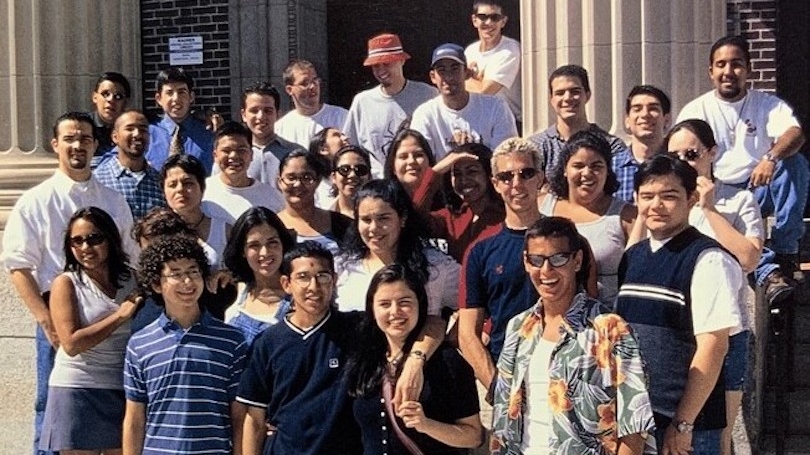
- About
- Departments & Programs
- Faculty Resources
- Governance
- Diversity
- News
Back to Top Nav
Back to Top Nav
Back to Top Nav
Back to Top Nav
Students detail the struggles of their predecessors to achieve better Latinx representation on campus in the late 20th century.
When Melissa Reyes '25 was researching the history of Dartmouth's Latinx community this past spring, she discovered a familiar theme. Like her generation, Latinx students at Dartmouth in the 1980s and 90s emphasized the concept of "familismo"—a central Latinx cultural value Reyes describes as a focus on creating solidarity among Latinxes through community building initiatives.
Founded in 1985, La Alianza Latina was one of the first student organizations at Dartmouth dedicated to Latinx students. Among its many efforts, the group advocated for a dedicated space for the Latinx community on campus and hosted cultural events to foster a shared sense of identity.
"Dartmouth Latinx organizations still use the concept of familismo that La Alianza Latina carried out in its promotional activities to create and maintain a strong community of Latinx students," Reyes says. "It's so important for Latinx students like myself to be part of a community where we can engage in our culture and learn more about others in the process."
A newly published digital exhibit developed by Reyes and her classmates in last spring's "Introduction to Latino Studies" class explores student- and faculty-led efforts to achieve better Latinx representation on campus in the 1980s and 90s and the development of Dartmouth's Latin American, Latino, and Caribbean Studies (LALACS) program.
Students visited the Rauner Special Collections Library throughout spring term to research the Latinx campus experience. They examined the papers of longtime faculty member and distinguished historian Maryssa Navarro, organizational papers of Latinx student groups, administrative correspondences, and more.
"It's so crucial and empowering to unveil Latinx voices at Dartmouth," Reyes says. "As a Chicana feminist scholar, I find it inspiring to see the multiple routes Latinx students took when organizing in mutual solidarity. These students made it possible for me to walk on the same grounds they did."
A Partnership with Dartmouth Library
Dartmouth research librarian Jill Baron first discovered the archived papers of Marysa Navarro through a project by Emmanuel Mariano '23, who served as a 2022 research fellow as part of the Historical Accountability Student Research Program at the library. The program offers research opportunities for undergraduates to explore primary sources in the library's collections related to issues of diversity and inclusion in Dartmouth history. As his final project, Mariano created a video essay about Navarro.
When Baron discovered that professor Bryan Winston was preparing to teach "Introduction to Latino Studies," she suggested that his students explore Navarro's papers. Not long before spring term, Baron and Winston visited Rauner and looked through Navarro's papers as well as other holdings related to LALACS and Latinx students at Dartmouth.
"We were both intrigued by what we found," Winston says. He decided that producing a digital exhibit would allow students to learn how to interpret archival documents for a larger audience— and share a relatively unknown part of Dartmouth's history with others. "In my mind, the exhibit would be a way for current and future students to engage with Dartmouth's efforts—both its failures and successes—to recruit Latinx students and respond to the growth of ethnic studies (specifically Latino studies) in the latter part of the 20th century."
Baron introduced Winston to Morgan Swan, special collections librarian for teaching and scholarly engagement, who identified relevant collections and items from the archives. Swan also facilitated a class visit where students practiced "primary source literary skills"—interpreting and contextualizing primary sources, synthesizing information, and crafting historical narratives.
After several weeks of research, Laura Braunstein, head of digital scholarly engagement, worked with the class to conceptualize the digital exhibit. Students then organized their content visually and developed copy for a public audience.
Critical Inquiry into Dartmouth's Past
The exhibit details the challenges Latinx students and faculty faced as they sought to establish the LALACS program and bring more Latinx students and faculty to campus. Despite more than a decade of advocacy for greater Latinx representation on campus, LALACS wasn't established until 1998.
"Some sections show how crucial students' organizing was to expanding Dartmouth's recruitment of Latinx students and the hiring of faculty to ensure there were Latino studies courses," Winston says. "There are also interesting discoveries about art, programming, and social life that show a Latinx student body determined to claim belonging on campus despite the varying obstacles placed in their way."
Reyes recalls an archival document that revealed there was no institutional acknowledgement of the existence of a Spanish-speaking community at Dartmouth until the spring of 1979. "I find it appalling today to think about Dartmouth's slow progress," Reyes says. "I still have many questions on why it took so long for Dartmouth to formally acknowledge the presence of a Latinx or Hispanic community in the first place."
Winston views the exhibit's findings as opportunities for further inquiry. "The students in this course created something that sheds a new light on Dartmouth and has opened a path for future research," he says.
"By compiling this narrative, one recognizes the historic struggle Latinx alumni underwent in transforming Dartmouth into a place that they and future students deserve to occupy," Reyes says. "Their struggles must be documented, acknowledged, and remembered."